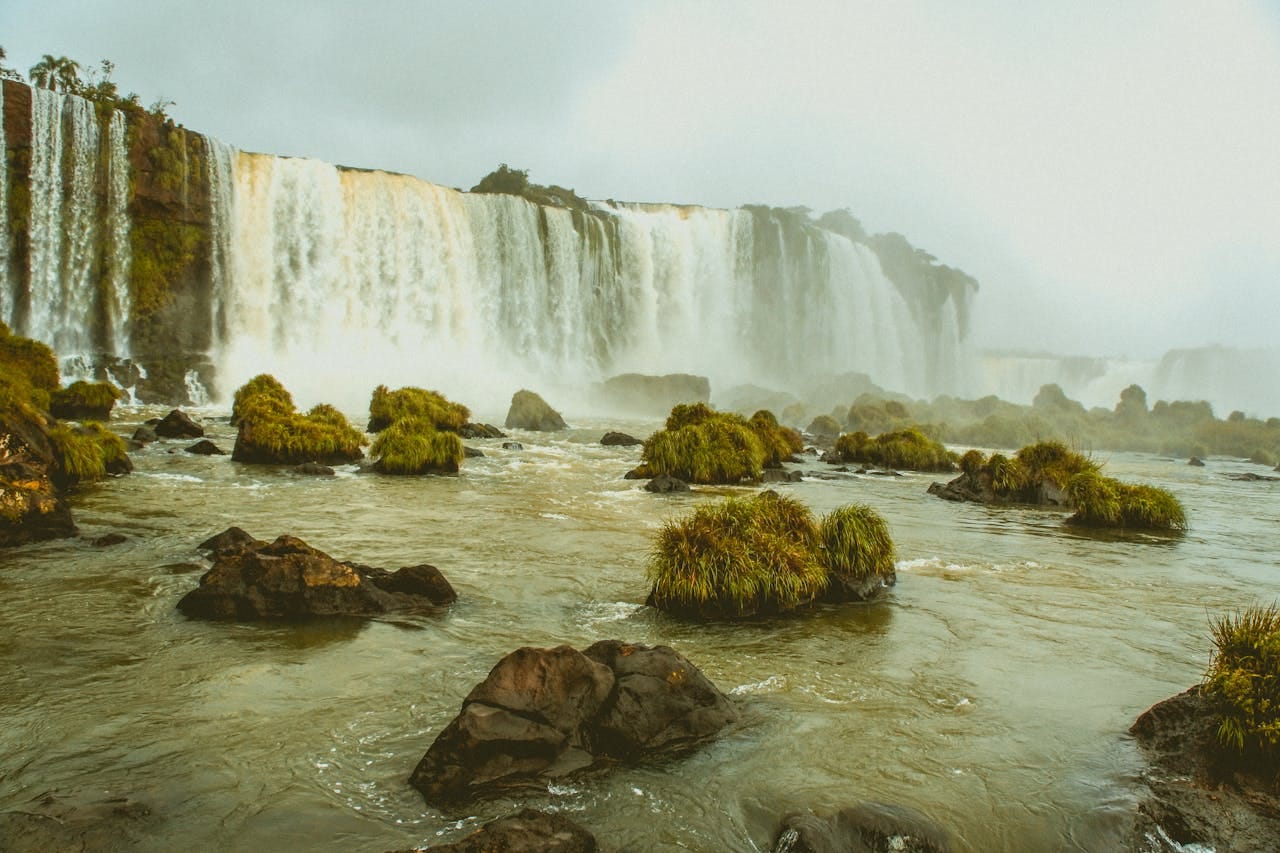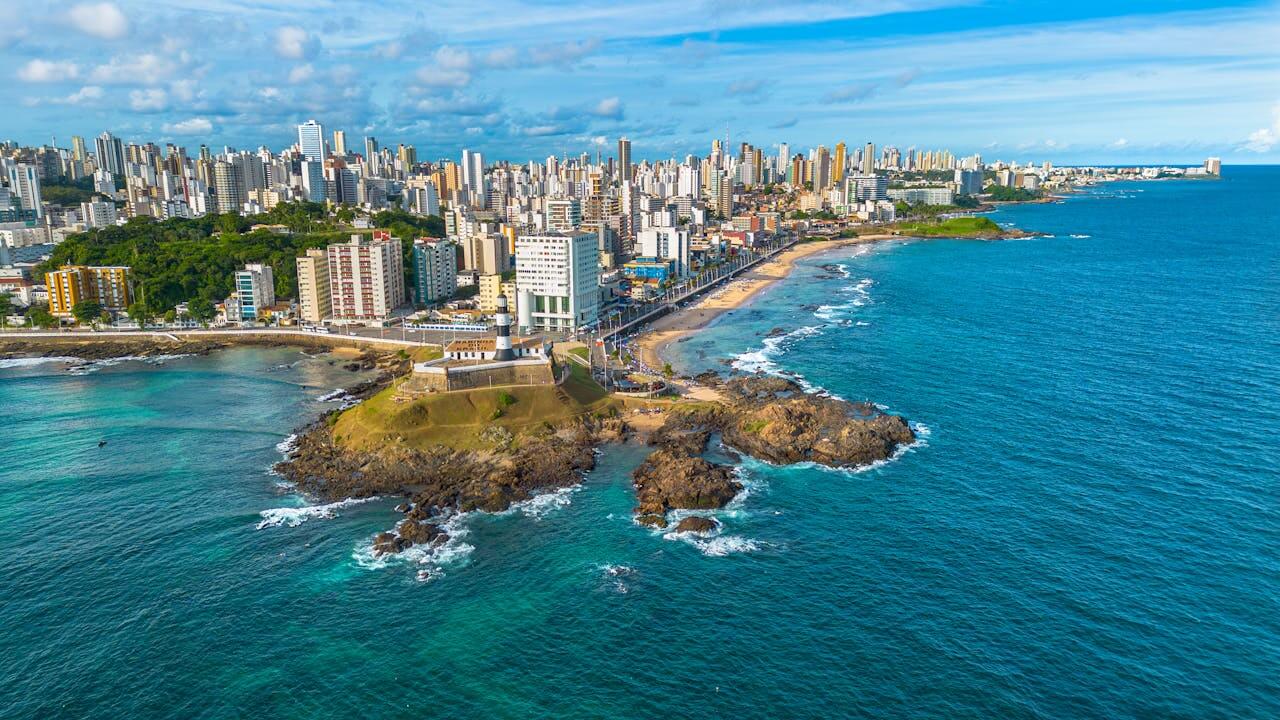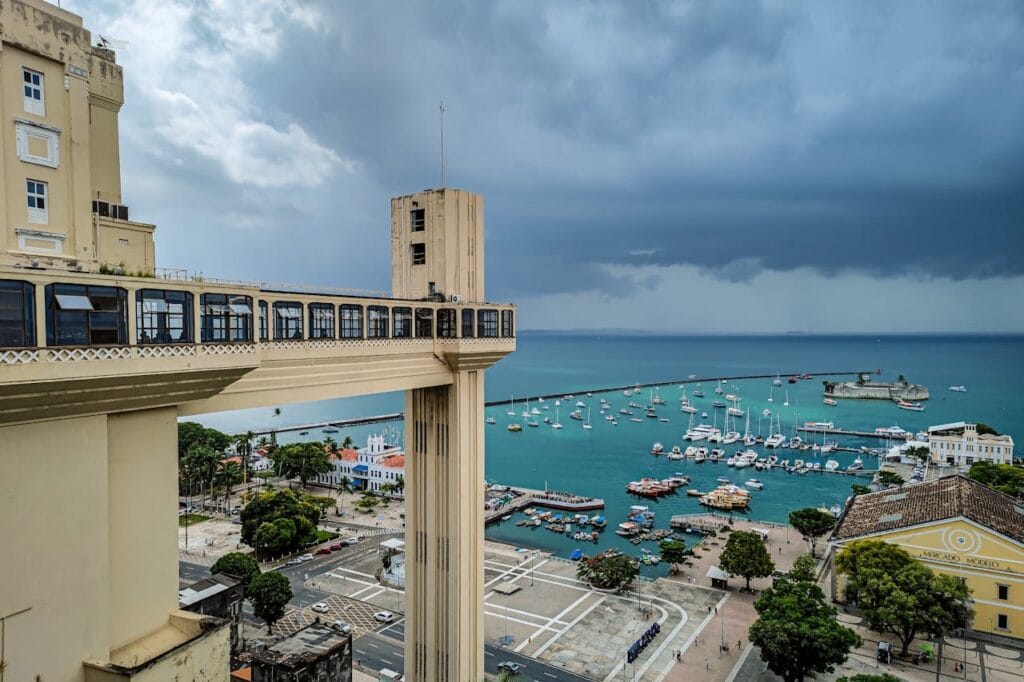
Salvador, the capital of Brazil’s Bahia state, is a city that pulses with history, culture, and energy.
As the heart of Afro-Brazilian heritage, it captivates visitors with its cobblestone streets, colonial architecture, vibrant rhythms, and rich cuisine. But beyond its fascinating past, Salvador is a lively and dynamic destination where tradition meets modernity.
From stunning beaches to the excitement of Carnival, there’s always something to explore.
In this Salvador Travel guide, you’ll find everything you need to plan your trip and make the most of this incredible city! Let’s dive in!
✈️ Airports: Salvador International Airport – Deputado Luís Eduardo Magalhães (SSA), which is located approximately 28 km from the city center.
⏰ Time Zone: BRT (Brasília Time), UTC/GMT -3 hours
🌡️Climate: Salvador is a typical tropical city with a hot and humid climate, featuring an average temperature of 25-30°C (77-86°F).
💰 Currency: Brazilian Real (BRL)
🗣 Language: Portuguese (English is not widely spoken)
🎫 Brazil Visa: As of April 10, 2025, travelers from the United States, Australia, and Canada will need a visa to enter Brazil. However, most Europeans, South Americans, and Japanese citizens do not require a visa. Head here to see if you need a Brazil travel visa.
🔌 Electricity Socket: The outlets in Brazil are mostly Type N (three round pins) and Type C (two round pins). In most hotels and rental apartments, the majority of outlets are 127V, but certain outlets, particularly in bathrooms and kitchens, are 220V. These specific outlets are usually labeled to indicate their voltage. Visitors from other countries, including the U.S., are advised to bring a universal adapter to use electrical devices from abroad and check their devices for compatibility with the voltage.
📲 Brazil SIM Card: Curious if you need a SIM card for Brazil? The answer is absolutely yes! Every traveler will benefit from having one, and this article dives into all the details about the best SIM card options for Brazil. For a convenient and fast solution, consider getting an eSIM from Airalo – it works right after landing and skips the hassle of physical SIM cards.
Sign up Now for the Best Travel Tips exploring Brazil!
Get expert travel tips, detailed itineraries, and insider recommendations for your trip.
General Information About Salvador
A Brief History
Salvador was founded in 1549 by Portuguese settlers and served as Brazil’s first capital until 1763. The city was strategically built on All Saints’ Bay, providing easy access to the coast and facilitating defense against foreign invasions.
During the 16th and 17th centuries, Salvador became a major hub for the sugar trade, with plantations in the region exporting sugar to Europe.
The city was also one of the largest centers of the transatlantic slave trade, receiving thousands of enslaved Africans who were forced to work on plantations and in urban construction.
Throughout the 20th century, Salvador underwent significant transformations, establishing itself as a cultural and tourist center. In the 1940s, efforts to preserve Pelourinho, the city’s historic center, led to its restoration and designation as a National Historic Landmark. In 1985, it was recognized as a UNESCO World Heritage Site.
Today, Salvador is one of Brazil’s top tourist destinations, preserving its history and traditions while embracing modernity. The city maintains its strong Afro-Brazilian identity, expressed through music, religion, cuisine, and festivals.
Its Carnival is recognized as one of the largest in the world, and Salvador remains a cultural and creative hub, attracting millions of visitors each year.
Where is Salvador Located?
Salvador is the capital of the state of Bahia, located in northeastern Brazil, along the Atlantic Ocean. The city sits on All Saints’ Bay (Baía de Todos os Santos), one of the largest bays in the world.
Population and Demographics
Currently, Salvador has around 2.9 million inhabitants, making it the fourth-largest city in Brazil by population. It is one of the most ethnically diverse cities in the country, with a majority of its residents identifying as Afro-Brazilian.
Beaches in Salvador
Salvador is blessed with a stunning coastline and some of Brazil’s most beautiful beaches. Whether you’re looking to relax, swim, or surf, there’s a beach for everyone, such as Porto da Barra, Stella Maris, Flamengo, and Itapuã. Check out the best beaches in Salvador here!
Religious Diversity
Religion plays a significant role in Salvador’s culture. While the majority of the population is Roman Catholic, the city is also home to Candomblé, an Afro-Brazilian religion that blends African traditions with elements of Catholicism. Visitors can witness Candomblé ceremonies and learn about its spiritual practices.

Is Salvador Worth Visiting?
Absolutely, yes! Salvador offers a mix of history, culture, cuisine, beaches, and major festivals. The city has colonial architecture, Afro-Brazilian traditions, and a strong musical and artistic scene. Key attractions include Pelourinho, Bonfim Church, Mercado Modelo, and the beaches of Porto da Barra and Flamengo.
Salvador also hosts Carnival, one of the largest street festivals in the world. It is a destination for those interested in cultural heritage, local cuisine, and coastal landscapes.
What is the Best Time to Visit Salvador?
Salvador is one of those destinations that can be enjoyed year-round, thanks to its warm tropical climate and cultural scene. While the city never gets truly cold, and temperatures remain relatively consistent throughout the year, there are some seasonal variations that can affect your travel plans. Here’s a breakdown of the best times to visit Salvador, depending on your preferences:
Climate Overview
Salvador enjoys a tropical climate, with average temperatures ranging from 25°C to 30°C (77°F to 86°F) year-round. The city has two main seasons: the dry season (from late August to mid-March) and the rainy season (from April to July).
While the weather is generally pleasant, the rainy season can bring overcast skies and occasional downpours, which might disrupt outdoor activities.
Dry Season (Late August to Mid-March)
The dry season is widely considered the best time to visit Salvador. During this period, the weather is warm and sunny, with minimal rainfall, making it perfect for beach days, outdoor exploration, and cultural activities. Here’s what to expect:
- December to February: This is high season in Salvador. The weather is at its best, with almost no rain, and the city is buzzing with energy. It’s a great time for beach lovers and those who enjoy a festive atmosphere. However, this is also the busiest time of year, with more tourists and higher prices for accommodations and tours.
- Carnaval: If you’re visiting in February or early March, you’ll experience Salvador’s famous Carnaval, one of the largest and most vibrant in the world. While it’s an unforgettable experience, keep in mind that prices skyrocket during this period, and the city gets extremely crowded.
- March: After Carnaval, the city starts to calm down, and the weather remains pleasant. It’s a good time to visit if you want to enjoy the beaches and attractions with fewer crowds.
Rainy Season (April to July)
The rainy season in Salvador is characterized by more frequent rain showers and overcast skies. While this might not be the best time for beach activities, it’s still a great time to visit if you’re interested in cultural experiences and indoor attractions. Here’s what to know:
- Low Season: This is the lowest tourist season, meaning fewer crowds and lower prices for accommodations and tours.
- Cultural Activities: With occasional rain, it’s a good time to explore Salvador’s museums, historic sites, and restaurants. The city’s Afro-Brazilian culture can be enjoyed year-round, rain or shine.
- Beaches: While the beaches might not be ideal during this time, you can still enjoy them on sunny days between rain showers.
Mid-Season (August to November)
The period from August to November is a sweet spot for visiting Salvador. It’s considered the mid-season, offering a balance of good weather, fewer crowds, and reasonable prices. Here’s why it’s a great time to visit:
- Stable Weather: The rain decreases, and the weather becomes more predictable, making it a good time for beach activities and outdoor exploration.
- Lower Prices: Accommodation and tour prices are more affordable compared to the high season, making it a budget-friendly option.
- Less Crowded: If you prefer a more relaxed atmosphere without the hustle and bustle of high season, this is the perfect time to visit.
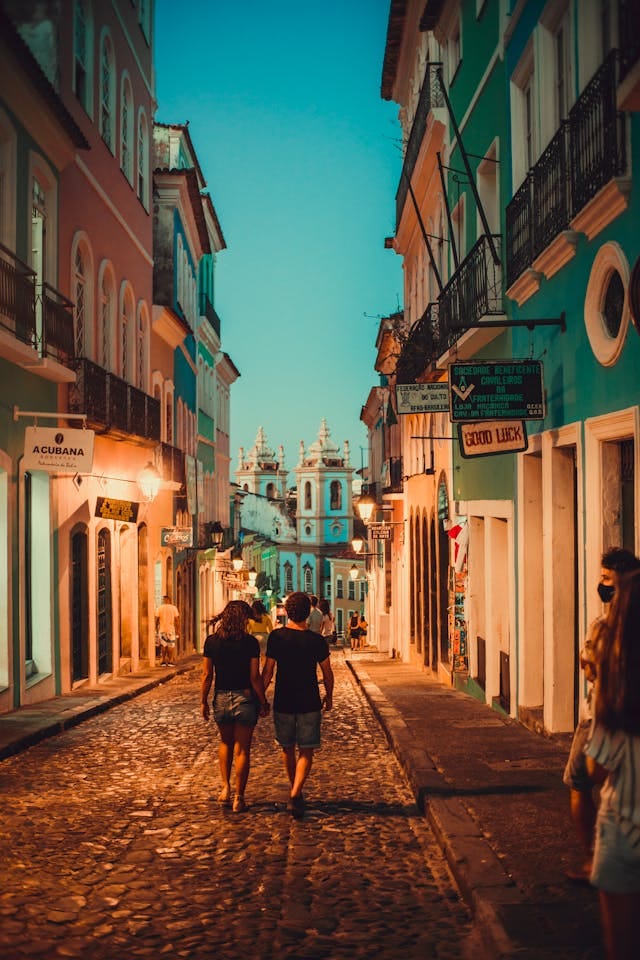
How to Get to Salvador?
Salvador is a major destination in Brazil, and getting there is relatively easy thanks to its well-connected transportation options. Whether you’re traveling domestically or internationally, here’s everything you need to know about reaching this city:
By Air
The most convenient and recommended way to get to Salvador is by flying into Salvador International Airport – Deputado Luís Eduardo Magalhães (SSA). Located approximately 28 km from the city center, this airport is one of the busiest in Brazil and offers a wide range of domestic and international flights.
Salvador is well-connected to major Brazilian cities, including São Paulo (2-hour flight), Rio de Janeiro (2.5-hour flight), Brasília (2-hour flight), Belo Horizonte (2-hour flight), Recife (1.5-hour flight), Fortaleza (2-hour flight), Porto Alegre (3.5-hour flight).
Given Brazil’s continental size, flying is the most practical option for travelers coming from other parts of the country.
Salvador’s airport also operates direct or seasonal flights to several international destinations, including Lisbon (Portugal), Madrid (Spain), Paris (France), Buenos Aires (Argentina), Montevideo (Uruguay), and Santiago (Chile).
For travelers from North America, Europe, or other regions, connecting flights through major hubs like São Paulo or Rio de Janeiro are usually required.
Once you arrive at Salvador International Airport, you’ll have several options to reach the city center or your accommodation:
- Uber/Taxi: The most convenient and cost-effective option. Uber is widely available and often cheaper than traditional taxis.
- Metro: The airport has a metro station, but the lines don’t reach most tourist areas. You can take the metro to the city center and then switch to a taxi or Uber for the final leg of your journey.
- Bus: Executive bus line 1001-00 runs from the airport to popular tourist areas like Barra and Pelourinho. It’s an affordable option, though less convenient than Uber or taxis.
- Private Transfer: Many hotels and tour operators offer private transfer services, which can be arranged in advance.
By Car
While it’s possible to drive to Salvador, it’s not the most recommended option due to the long distances and road conditions, such as the 1,600 km (20+ hours) drive from Rio de Janeiro or the 1,950 km (25+ hours) drive from São Paulo.
The roads in Bahia are not always in the best condition, with potholes and uneven surfaces being common. Additionally, parking in Salvador can be challenging, so it’s essential to choose accommodation with private parking if you plan to drive.
By Bus
Salvador’s Bus Terminal is located about 8 km from Pelourinho, 13 km from Farol da Barra Beach, and 23 km from the airport. While bus travel is the most budget-friendly option, it involves long hours on the road, such as 24 hours from Rio de Janeiro or 30 hours from São Paulo.
Once you arrive at the bus terminal, you can take an urban bus, Uber, or taxi to your final destination. For those heading to the Litoral Norte (e.g., Praia do Forte), shuttle vans are available from the terminal.
By Cruise
Salvador is a popular port of call for many cruise lines, making it a unique way to arrive in the city. Some of the cruise ships that stop in Salvador include MSC Grandiosa, MSC Seaview, MSC Orchestra, and Silver Ray.
If you’re arriving by cruise, you’ll dock at the Port of Salvador, which is close to the city center and major attractions like Pelourinho.
Where to Stay in Salvador?
See on the map above that Salvador’s tourist area forms a corridor stretching from Santo Antônio Além do Carmo to Rio Vermelho, passing through famous areas such as Pelourinho, Vitória, Barra, and Ondina.
These are the main neighborhoods where tourists usually stay due to their proximity to historical and cultural attractions, as well as beaches.
A bit farther away is Itapuã, a region known for its beautiful beaches and a more relaxed atmosphere, ideal for those looking to unwind away from the city’s hustle and bustle. See below for the characteristics of each neighborhood:
Pelourinho

Pelourinho is the historic heart of Salvador. It’s ideal for travelers who want to immerse themselves in the city’s history and culture. The area is filled with colonial buildings, historic churches like São Francisco, and lively squares.
You’ll also find museums, such as the Museu Afro-Brasileiro, and plenty of restaurants. Accommodation options range from luxury hotels to budget-friendly hostels.
However, safety can be a concern at night, so it’s best to stick to well-lit, busy areas and avoid wandering off the main streets.
📌 Go deeper with neighborhood pros/cons in Best Places to Stay in Salvador Brazil.
Santo Antônio Além do Carmo

Located just beyond Pelourinho, Santo Antônio Além do Carmo offers a quieter, more bohemian atmosphere while still being close to the historic center.
This area is good for travelers who want to stay in a charming, colonial-style neighborhood without the crowds of Pelourinho.
The streets are lined with colorful houses, and there are plenty of cafes, bars, and artisan shops. Accommodation here is mostly guesthouses and boutique pousadas, making it a great choice for a more personalized stay.
Vitória
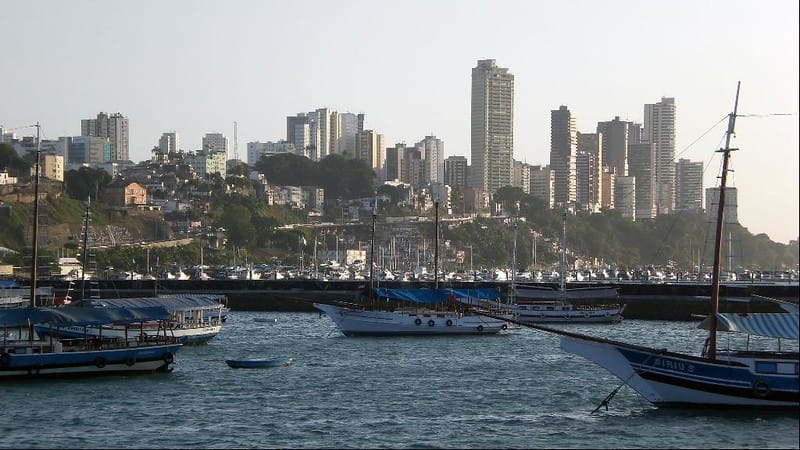
This upscale district is strategically located between the historic center and Barra, making it convenient for exploring both areas.
Known for its luxury hotels, high-end residential buildings, and cultural attractions, Corredor da Vitória offers a refined experience. It’s a safe and comfortable area, though accommodation prices tend to be higher.
Barra
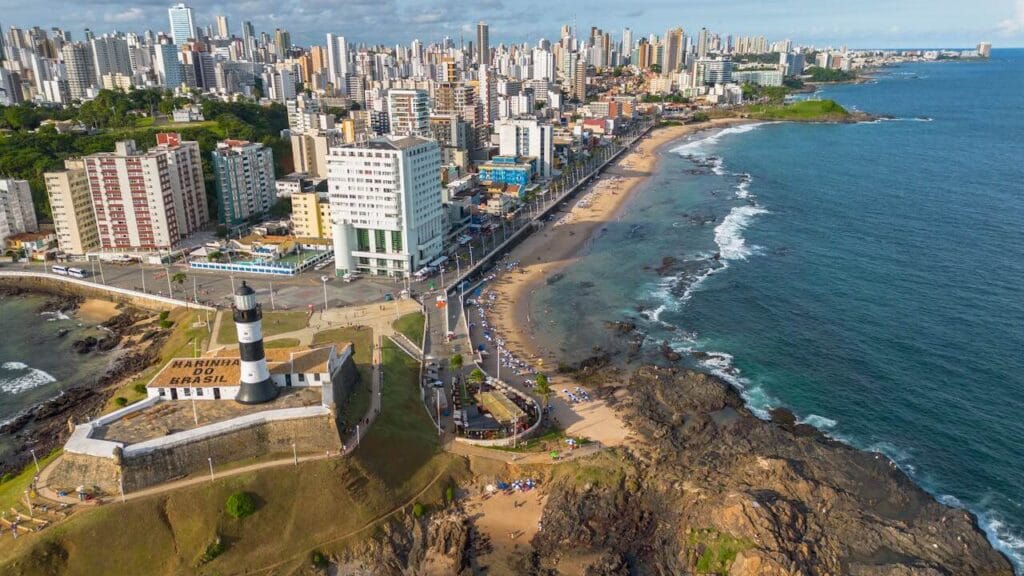
Barra is one of the most popular areas for tourists, especially first-time visitors. It’s known for its beautiful beaches, including Porto da Barra and Farol da Barra, as well as its lively atmosphere.
The neighborhood has a good mix of restaurants, shops, and bars, and it’s well-connected to other parts of the city. Accommodation options in Barra cater to all budgets, from mid-range hotels to affordable guesthouses.
It’s also considered one of the safer areas in Salvador, making it a great choice for families and solo travelers alike.
👉 Find the best places to stay in Salvador on Hoteis.com. For budget travelers, Hostelworld has great hostel options in Salvador with good locations and atmosphere.
Ondina

Ondina is a quieter, more residential neighborhood located between Barra and Rio Vermelho. It’s a good option for those who want to be close to the beach without the hustle and bustle of Barra.
The beach in Ondina is smaller and less developed for tourists, but the neighborhood provides easy access to both nightlife and cultural attractions.
Ondina is particularly popular during Carnival, as it’s part of the famous Barra-Ondina circuit. However, accommodation options are limited, so it’s best to book well in advance if you plan to stay here.
Rio Vermelho
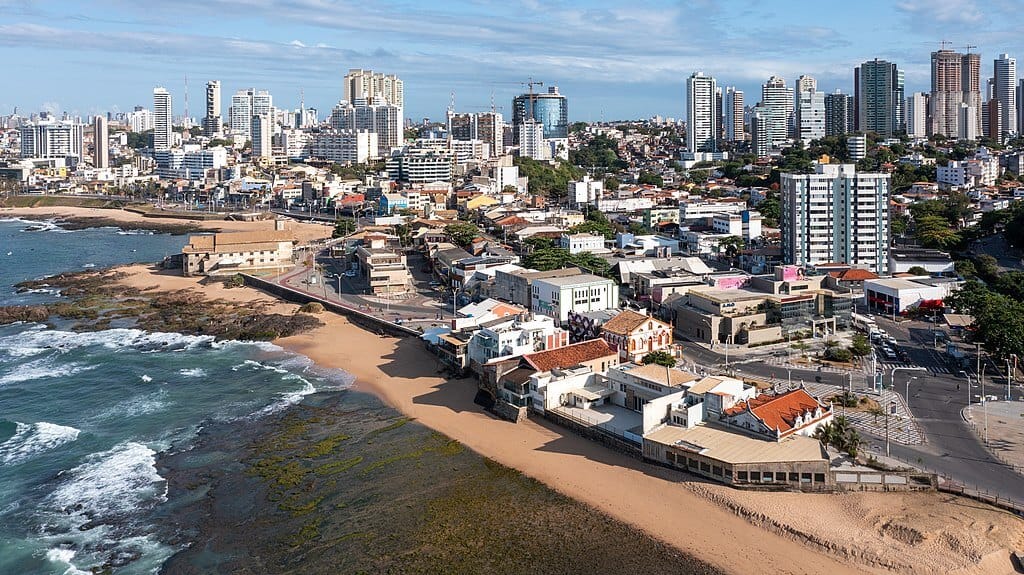
Rio Vermelho is the go-to neighborhood for nightlife and food lovers. Known for its lively bars, restaurants, and street food, this area is perfect for travelers who want to experience Salvador’s nightlife.
The neighborhood is also home to two beautiful beaches and is famous for its acarajé stalls around Largo de Santana. While Rio Vermelho is generally safe, it can get noisy at night, so it may not be the best choice for those seeking a quiet stay.
Itapuã
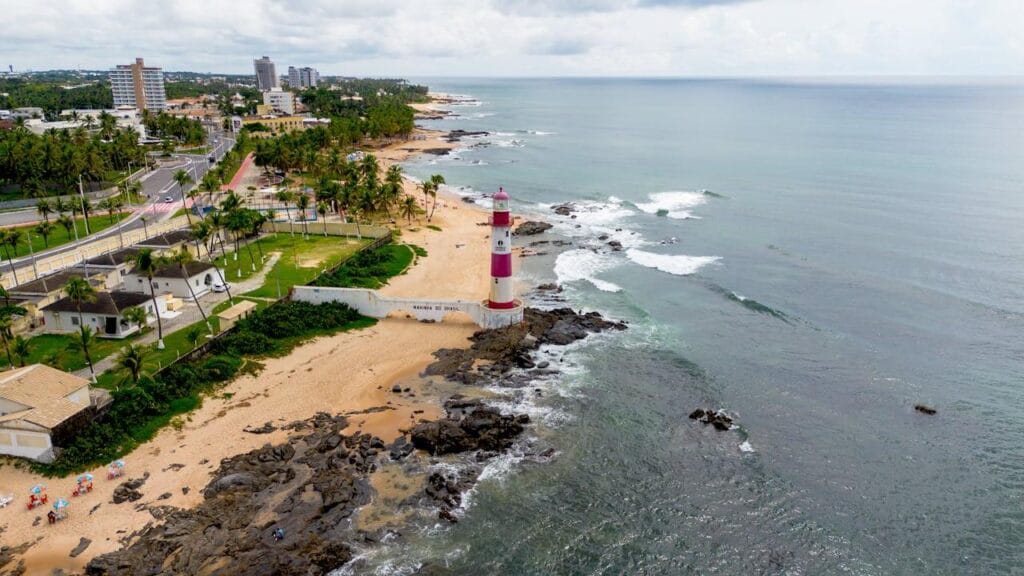
If you’re looking for a beach-focused stay, Itapuã is the place to be. Located further north, this area is known for its beautiful beaches, such as Itapuã, Stella Maris, and Flamengo.
It’s a great choice for travelers who want to relax by the sea and enjoy a more laid-back vibe.
However, Itapuã is quite far from the city center (around 25 km), so it’s better suited for repeat visitors or those who don’t mind the distance.
The area has a good selection of beachfront resorts and hotels, but it’s important to be cautious at night, as it can be less safe than other neighborhoods.
Best Things to Do in Salvador
Salvador is a city full of history, culture, and natural beauty, offering a wide range of activities for every type of traveler. Here’s a list of the best things to do in Salvador to make the most of your trip:
1. Explore Pelourinho
Pelourinho, the historic heart of Salvador, is a must-visit. This UNESCO World Heritage Site is filled with colorful colonial buildings, historic churches like São Francisco, and lively squares.
Spend a day wandering its cobblestone streets, visiting museums like the Museu Afro-Brasileiro, and enjoying the atmosphere. Don’t miss the chance to listen to live music and experience the local culture.
2. Ride the Lacerda Elevator
The Lacerda Elevator is one of Salvador’s most famous landmarks. It connects the Upper City (Cidade Alta) with the Lower City (Cidade Baixa) and offers stunning views of the bay. A quick ride on this historic elevator is a great way to get a perspective of the city.
👉 Discover Salvador from every angle — take a City Highlights Private Tour to visit the main landmarks, and explore its deep Afro-Brazilian Roots on a cultural journey guided by locals.
3. Watch the Sunset
Salvador is known for its breathtaking sunsets. Some of the best spots to watch the sun go down include the Ponta do Humaitá, the top of the Lacerda Elevator, the Farol da Barra, and the Solar do Unhão. For a more relaxed experience, head to the beaches of Porto da Barra or Ribeira.
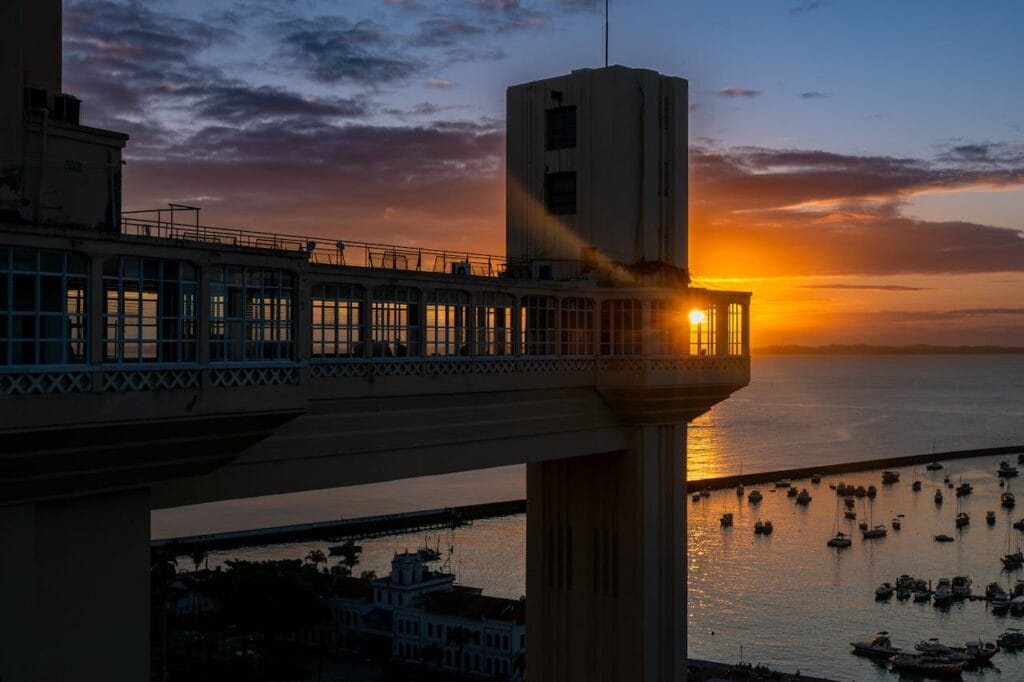
4. Visit Salvador’s Beaches
Salvador boasts beautiful beaches, both in the city center and further afield. Popular options include Porto da Barra, and Farol da Barra. For quieter spots, visit Stella Maris or Flamengo, located a bit further from the city center. While some central beaches are not ideal for swimming, they are perfect for relaxing and enjoying the views.
5. Walk from Porto da Barra to Farol da Barra
A scenic 1 km walk along the coastline between Porto da Barra (Barra Port) and Farol da Barra (Barra Lighthouse) is a must-do. This route offers stunning views of the Baía de Todos os Santos and is especially magical at sunset. Along the way, you can stop for a swim or take photos of the scenery.

6. Visit the Farol da Barra and Forte de Santo Antônio
The Farol da Barra (Barra Lighthouse) is one of Salvador’s most famous landmarks. Climb to the top for panoramic views of the city and explore the nearby Forte de Santo Antônio (Fort of Saint Anthony), which houses the Museu Náutico da Bahia (Bahia Nautical Museum). End your visit with a drink at the bar located at the base of the fort.
7. Take a Day Trip to Praia do Forte
Located about 80 km from Salvador, Praia do Forte is a charming beach town known for its crystal-clear waters and the Projeto Tamar, a sea turtle conservation project. It’s a great destination for a day trip, offering a mix of relaxation and nature.
This day trip to Praia do Forte and Guarajuba is a favorite among visitors — with hotel pick-up and stops for swimming, sunbathing, and enjoying the natural beauty of Bahia’s coastline.
8. Visit Ilha dos Frades and Ilha de Itaparica
A boat trip to Ilha dos Frades (Frades Island) and Ilha de Itaparica (Itaparica Island) is a fantastic way to explore the Baía de Todos os Santos. These islands are known for their pristine beaches, lush landscapes, and charming villages. Many tours include stops for swimming, snorkeling, and enjoying local seafood.

9. Explore Salvador’s Museums
Salvador is home to several museums that showcase its rich history and culture. Highlights include the Museu de Arte Moderna (MAM), the Museu Afro-Brasileiro, and the Museu Náutico da Bahia. For a deeper dive into local culture, visit the Casa do Carnaval, the Fundação Casa de Jorge Amado, and Casa do Rio Vermelho – Jorge Amado Museum.
10. Visit Salvador’s Churches
Salvador’s churches are a testament to its colonial past and religious diversity. Don’t miss the Igreja de São Francisco, known for its gold-covered interior, the Catedral Basílica de Salvador, and the Igreja Nosso Senhor do Bonfim, famous for its colorful ribbons.
11. Shop at Mercado Modelo
Mercado Modelo is the perfect place to shop for souvenirs, handicrafts, and local art. With over 250 stalls, you’ll find everything from traditional clothing to handmade jewelry. It’s also a great spot to try local snacks and drinks.

12. Try Bahian Cuisine
Salvador is a food lover’s paradise. Don’t miss trying acarajé, moqueca, and other Afro-Brazilian dishes. For a more upscale dining experience, visit restaurants like Casa de Tereza or Amado. Be sure to also try local desserts like cocada (coconut sweet) and drinks like caipirinha.
Don’t miss trying the famous ice creams at Sorveteria da Ribeira and Sorveteria A Cubana, two beloved spots in Salvador known for their delicious treats.
See here our full guide to the best restaurants in Salvador.
13. Experience Salvador’s Nightlife
Salvador comes alive at night, especially in neighborhoods like Rio Vermelho and Santo Antônio Além do Carmo. Enjoy live music, dance to axé and samba, or relax at a bar with a caipirinha in hand. The city’s nightlife is vibrant and diverse, catering to all tastes.
14. Attend Carnival
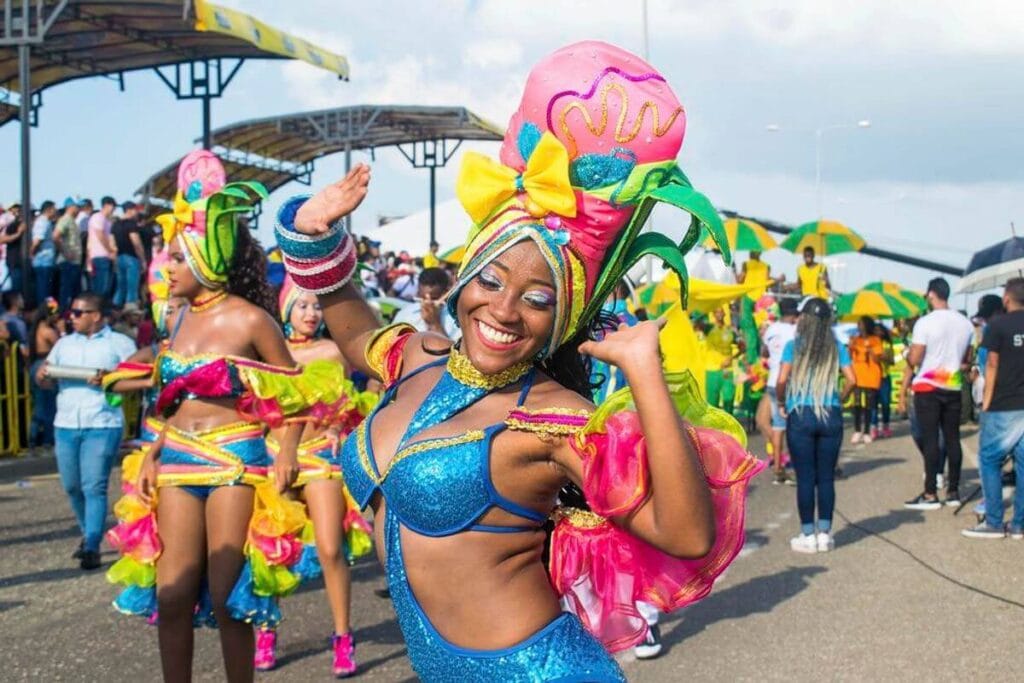
If you’re visiting in February or early March, don’t miss Salvador’s Carnival, one of the largest and most vibrant in the world. The streets fill with music, dance, and colorful parades, creating an unforgettable experience.
15. Take a Catamaran Tour
A catamaran tour of the Baía de Todos os Santos (All Saints’ Bay) is a great way to explore the bay’s islands and enjoy the coastline. Many tours include stops for swimming, snorkeling, and enjoying local cuisine.
16. Visit Morro de São Paulo
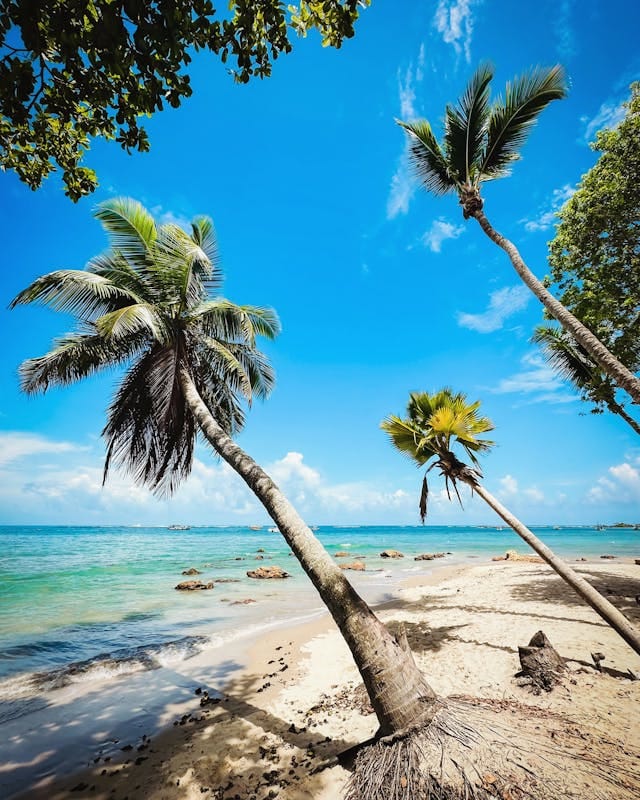
If you have extra time, consider a trip to Morro de São Paulo, a car-free island known for its stunning beaches and relaxed vibe. It’s a perfect getaway for those looking to unwind and enjoy nature.
👉 Want to visit without spending the night? This day tour from Salvador covers transportation and get the full Morro de São Paulo experience — beaches, food, and views in one trip.
What to Do at Night in Salvador
Salvador comes alive at night, offering a mix of lively nightlife, cultural experiences, and relaxed evenings by the sea. Here are the best things to do after the sun goes down:
1. Explore Rio Vermelho
Rio Vermelho is Salvador’s most famous nightlife district, known for its bars, restaurants, and live music. The area is particularly lively around Largo de Santana, a popular square, where you can try the iconic acarajé da Dinha while enjoying the bustling atmosphere. Vila Caramuru is another hotspot, with 24-hour quiosques (kiosks) offering drinks, snacks, and live performances.

2. Relax at Barra’s Waterfront
Barra’s waterfront is a popular spot for evening strolls and drinks. The area is lined with bars and restaurants where you can enjoy live music, cocktails, and the sea breeze. Don’t miss the chance to visit the Farol da Barra (Barra Lighthouse) at night for beautiful views and photo opportunities. Popular spots include Barravento, Restaurante Egeu, and Pereira Restaurante.
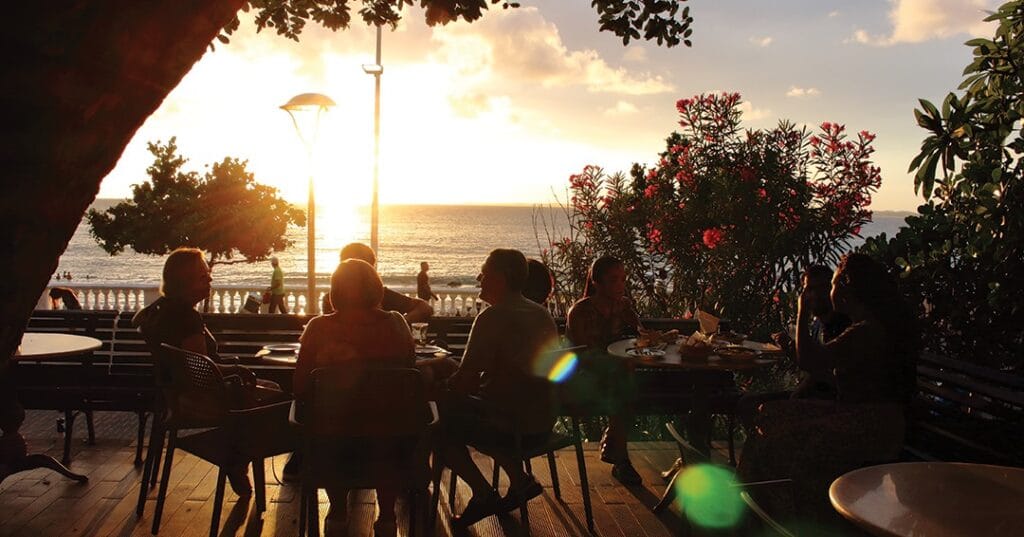
3. Discover Santo Antônio Além do Carmo
This charming neighborhood in the historic center has become a nightlife favorite, with its mix of traditional and modern vibes. Many bars and restaurants, such as Antique Bistrô, offer stunning views of the Baía de Todos os Santos, making it a perfect spot for a relaxed evening with drinks and local food.
4. Try Nighttime Street Food
Salvador’s street food scene is vibrant at night. Head to Largo de Santana or Vila Caramuru to try acarajé, a traditional Bahian dish, or enjoy other local snacks like abará and cocada (coconut sweet). For a more upscale dining experience, visit renowned restaurants like Amado or Mistura Contorno, which blend contemporary and traditional Bahian cuisine.

6. Visit Famous Bars and Nightclubs
Salvador has a variety of bars and nightclubs to suit all tastes. In addition to Rio Vermelho’s hotspots, explore places like Varanda do Sesi in Rio Vermelho, known for its lively atmosphere and live music, or Bar do Cravinho, a historic bar in Pelourinho famous for its cachaça-based drinks.
When it comes to nightclubs, you can head to San Boate, the top choice for the LGBTQIA+ community in Salvador, or Amsterdam, which offers an eclectic vibe with music ranging from electronic and funk to reggaeton. The club features multiple spaces, so you can choose the atmosphere and crowd that best suits your style.
5. Attend a Cultural Event or Festival
For cultural events, visit Teatro Castro Alves, Salvador’s most important cultural center, for theater performances, dance shows, and concerts. Teatro Vila Velha is another great option, known for its experimental and avant-garde productions. For a more intimate experience, check out Espaço Cultural da Barroquinha, which offers performances and art exhibitions in a historic setting.
Additionally, check out local event calendars for cultural festivals, live music, and dance performances happening at night. Salvador’s Afro-Brazilian culture is often celebrated through these events, offering a unique and immersive experience.
What Should You Eat in Salvador?

Salvador’s cuisine is a mix of African, Indigenous, and Portuguese influences, featuring bold flavors, aromatic spices, and fresh seafood. From street food to fine dining, here are the must-try dishes and drinks in the city:
Street Food & Traditional Dishes
- Acarajé – One of the most iconic foods of Bahia, this deep-fried black-eyed pea fritter is filled with vatapá (a creamy paste made of peanuts, shrimp, and coconut milk), caruru (okra stew), and dried shrimp. Found in street stalls, especially in acarajé da Dinha in Rio Vermelho.
- Abará – Similar to acarajé, but instead of being fried, it’s wrapped in banana leaves and steamed.
- Vatapá – A creamy paste made from peanuts, cashews, coconut milk, and bread, often served with acarajé or rice.
- Caruru – A flavorful okra-based stew, usually served as a side dish with seafood or meat.
- Moqueca Baiana – A rich seafood stew made with fish or shrimp, cooked in coconut milk, tomatoes, onions, and azeite de dendê (palm oil). Best enjoyed with rice and farofa. Popular places to try it include Restaurante Maria de São Pedro (Mercado Modelo) and Restaurante Ori (Barra).
- Xinxim de Galinha – A unique Bahian dish combining chicken and dried shrimp with ground peanuts and cashews, cooked in dendê oil.

Sweets & Desserts
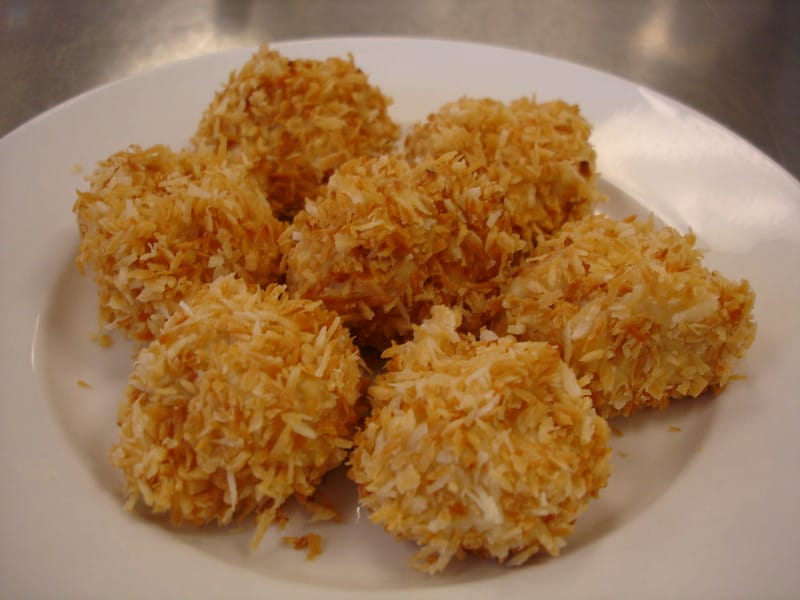
- Mungunzá (Mugunzá) – Known as canjica in other regions, this sweet dish is made from hominy corn, coconut milk, cinnamon, and sugar.
- Cocada – A traditional coconut-based sweet, found in many varieties, from soft to crunchy. Some bakeries and restaurants incorporate it into pastries and ice creams.
- Bolinho de Estudante – A deep-fried sweet treat made with tapioca and coconut, coated in sugar and cinnamon. Often served as a side to acarajé.
- Sorvete da Ribeira – One of the world’s best-rated ice cream parlors, offering exotic flavors like tapioca, umbu-cajá, and jenipapo. A must-visit spot!
Drinks & Refreshments

- Cachaça de Cravinho – A spiced cachaça infused with cloves, cinnamon, and other aromatics, found at the famous Bar do Cravinho (Pelourinho).
- Suco de Coco com Limão – A refreshing coconut and lime juice mix, popular in Pelourinho.
- Coconut Water – A staple drink, available fresh at beaches and street vendors.
How Many Days do You Need in Salvador?
Salvador is a city full of history, culture, and landscapes, and the time you’ll need depends on how deep you want to explore.
- 2-3 days – Just enough to see the main sights, including the Pelourinho, the Elevador Lacerda, the Mercado Modelo, and a couple of beaches like Porto da Barra or Farol da Barra. Ideal for those on a tight schedule.
- 4 Days – A more balanced trip, allowing time for beach hopping, museums, churches, and enjoying Salvador’s nightlife. You can explore Itapuã Beach, visit the Igreja do Bonfim, and enjoy the sunset at Ponta de Humaitá.
- 5-7 Days – The best option! You’ll experience the city at a relaxed pace, trying the best local food, discovering hidden gems, and taking day trips to Praia do Forte, Ilha dos Frades, or Morro de São Paulo.
For the best experience, stay at least 4 days—but the more, the better! Salvador is a city to be enjoyed without rush.
How Do You Get Around Salvador?

Getting around Salvador can be easy if you choose the right transportation. Here are the best options for tourists:
Uber and Taxis: The Best Option for Tourists
Uber is the most practical and safest way to travel between Salvador’s main attractions, such as Pelourinho, Barra, and Rio Vermelho. Rides are usually affordable, and paying through the app means you don’t need to carry cash. However, be mindful of rush hours when traffic can increase travel time and fares.
Taxis are also a reliable option and can be easily found at hotels, shopping centers, and major tourist spots. While they may be slightly more expensive than Uber for short distances, they can be a good alternative, especially late at night.
Is Renting a Car Worth It?
- If you are staying only in Salvador: No, it is not worth it. Traffic can be challenging, parking is difficult, and Uber is often cheaper and more convenient.
- If you plan to visit the northern beaches: Yes, renting a car can be a good option. It gives you more flexibility to explore places like Praia do Forte, Guarajuba, and Imbassaí. However, if you are going to Morro de São Paulo or Boipeba, renting a car is unnecessary since you will have to leave it on the mainland.
Walking in Salvador
Salvador is a city that invites exploration on foot, especially in its most famous areas. Tourist-friendly neighborhoods like Pelourinho, Barra, and Rio Vermelho are perfect for walking, with their charming streets, historic landmarks, and vibrant atmosphere.
In Barra, for example, you can stroll along the entire waterfront, taking in the scenic views and ending your walk with a sunset at the Farol da Barra. While walking is a great way to experience the city, it’s important to stay aware of your surroundings and avoid deserted streets, particularly at night.
Cycling in Salvador
Cycling is also a great way to get around Salvador, especially along the city’s bike-friendly routes. The seaside path between Rio Vermelho and Farol da Barra features bike lanes and offers ocean views, making it a popular choice for both locals and visitors.
You can rent one bike through the Bike Itaú (Tembici) app, which provides an affordable and convenient way to explore the city on two wheels.
Public Transportation: Best to Avoid
Salvador’s metro is useful for getting from the airport to the city center but does not serve the main tourist areas. Buses are not recommended for tourists as they can be uncomfortable and unsafe.
Water Transportation: Exploring the Islands
If you want to visit the islands of Baía de Todos os Santos (All Saints’ Bay), such as Itaparica and Morro de São Paulo, you can take ferries or speedboats from the Terminal Turístico Náutico da Bahia next to Mercado Modelo. These trips offer stunning views and are a great experience.
Is Salvador Safe for Tourists?

Salvador, like any major city, has its share of safety concerns, but with proper precautions, it can be a safe and enjoyable destination for tourists. Here’s what you need to know to stay safe during your visit:
General Safety Tips
- Stay in Well-Lit, Busy Areas: Stick to tourist-friendly neighborhoods like Pelourinho, Barra, and Rio Vermelho, especially at night.
- Avoid Displaying Valuables: Keep your phone, camera, and jewelry out of sight to avoid attracting unwanted attention.
- Use Secure Transportation: Opt for Uber, taxis, or private transfers instead of public buses, especially at night.
- Be Cautious with Street Vendors: Politely decline offers from persistent vendors, particularly around tourist hotspots like the Elevador Lacerda and Mercado Modelo.
- Keep Documents Safe: Leave your passport and important documents in your hotel safe, and carry photocopies instead.
Specific Precautions
- In Tourist Areas: Be mindful of pickpockets in crowded places like Pelourinho and Mercado Modelo. Keep your bag close to your body and avoid carrying large amounts of cash.
- On the Beach: Never leave your belongings unattended on the sand. Use lockers or take turns watching your items if you’re with a group.
- At Night: Avoid walking alone in poorly lit or deserted areas. Use trusted transportation to get around after dark.
- During Carnival: Use a money belt or hidden pouch (doleira) to keep your valuables safe in crowded areas.
Common Scams and How to Avoid Them
- Fitinha do Bonfim: Vendors may aggressively offer you a “free” ribbon (fitinha) and then demand payment. Politely decline or buy one from a shop instead.
- Overpriced Souvenirs: Be cautious when buying from street vendors, as prices can be inflated for tourists.
- Fake Tour Guides: Only book tours through reputable agencies or your hotel.
Driving and Parking
- Car Safety: If you rent a car, avoid leaving valuables inside, even in the trunk. Park in secure, well-lit areas.
- Traffic and DUI Laws: Salvador has strict DUI enforcement, so avoid drinking and driving.
Check out a more comprehensive and detailed article on safety in Salvador here.
What Day Trips Can You Take From Salvador?
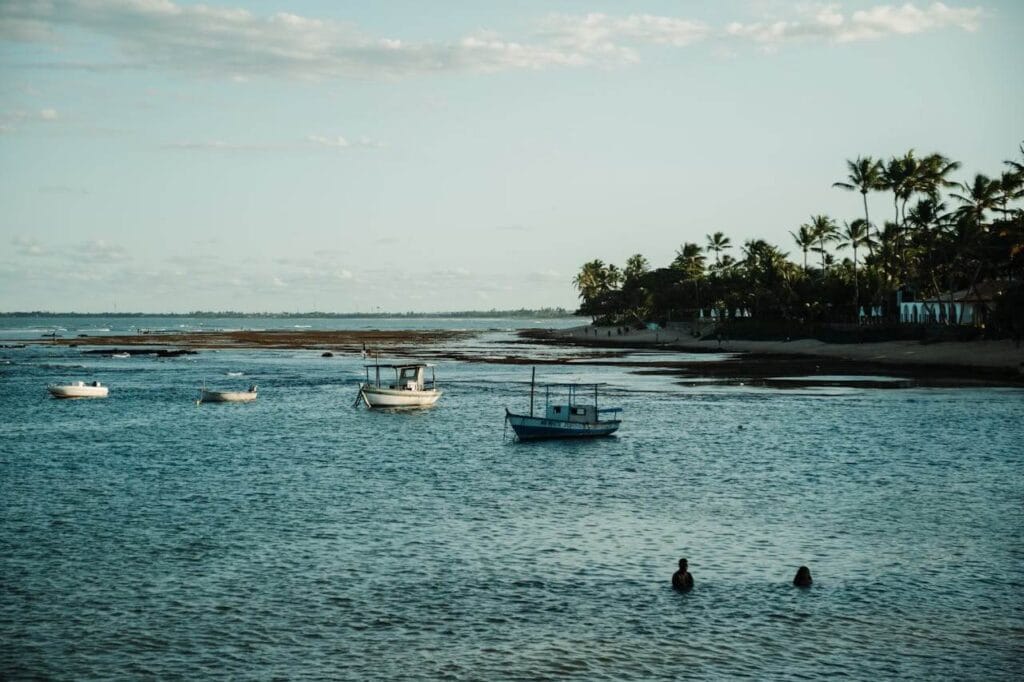
Salvador is not only rich in culture, history, and stunning beaches but also serves as a perfect base for exploring nearby attractions. Here are some day trips you can take from Salvador, including hidden gems and popular spots:
1. Praia do Forte
Located about 80 km from Salvador (a 1.5-hour drive), Praia do Forte is a coastal village known for its pristine beaches and coconut groves. Highlights include visiting the Projeto Tamar, a sea turtle conservation center. The village also offers excellent beachfront restaurants where you can enjoy local cuisine while soaking in the relaxed atmosphere.
2. Imbassaí
Approximately 70 km from Salvador (1.5 hours by car), Imbassaí is a tranquil beach town surrounded by vegetation and rivers. It’s perfect for relaxing, swimming, and enjoying nature.
3. Itaparica Island
Just 13 km from Salvador (1 hour by ferry), Ilha de Itaparica is the largest island in Todos os Santos Bay. It offers tranquil beaches, lush landscapes, and historic sites like the Forte de São Lourenço. Relax at Ponta de Areia Beach or Conceição Beach, and enjoy fresh seafood and local delicacies at beachfront restaurants.
4. Ilha dos Frades
Located about 30 km from Salvador (1.5 hours by boat), Ilha dos Frades is a secluded island with crystal-clear waters and untouched nature. It’s ideal for snorkeling, swimming, and hiking.
5. Morro de São Paulo
Around 60 km from Salvador (2.5 hours by ferry and boat), Morro de São Paulo is a car-free island with stunning beaches and a laid-back vibe. Highlights include relaxing at Second Beach or Fourth Beach, known for their natural pools.
While it’s possible as a day trip, staying overnight is highly recommended to fully enjoy the island.
6. Camaçari
Located about 50 km from Salvador (1 hour by car), Camaçari is known for its industrial hub but also boasts beautiful beaches like Guarajuba and Barra do Jacuípe.
7. Praia de Itacimirim
Located about 70 km from Salvador (1.5 hours by car), Praia de Itacimirim is a serene beach with calm waters and coconut groves.
8. Costa do Sauípe
Approximately 80 km from Salvador (1.5 hours by car), Costa do Sauípe is a luxurious resort area with stunning beaches and eco-adventures. Enjoy activities like zip-lining, horseback riding, and kayaking, or simply relax at Sauípe Beach, known for its golden sands and clear waters.
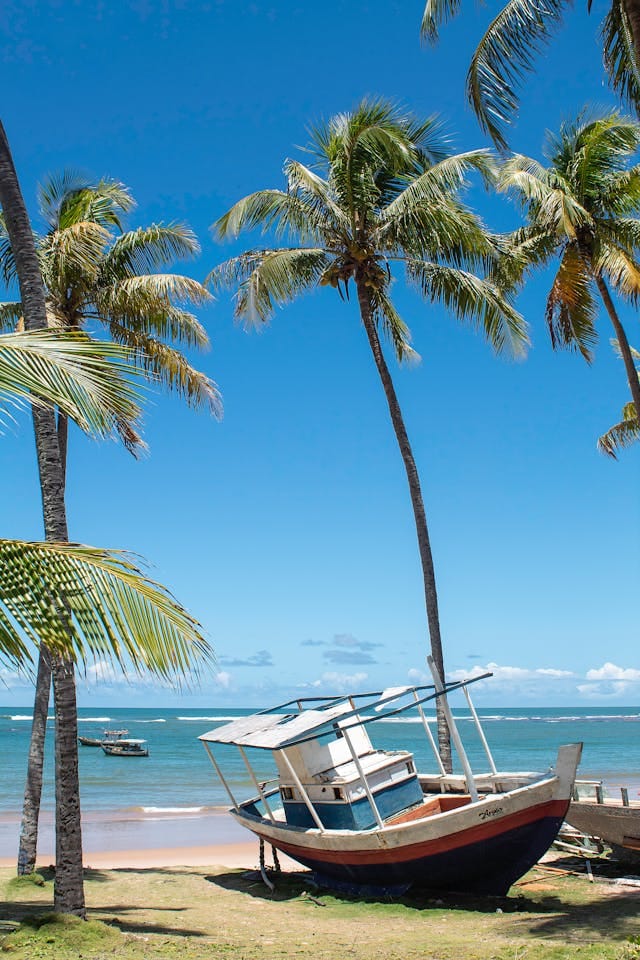
Extra Tips for Visiting Salvador
To make the most of your trip to Salvador and its nearby attractions, here are some practical tips to ensure a safe, comfortable, and enjoyable experience:
1. Dealing with Street Vendors and Services
- In popular tourist areas like Pelourinho, you’ll often encounter people offering services such as selling fitinhas do Senhor do Bonfim (wish ribbons), taking photos with traditional baianas (women in traditional Bahian attire), or offering henna tattoos.
- Tip: Be cautious and politely decline if you’re not interested. Once you engage, they may expect payment, even for small interactions.
- Avoid handing over your phone or camera to strangers for photos.
2. Dress Comfortably and Appropriately
- Salvador’s historic areas, like Pelourinho, have uneven and cobblestone streets, so wear comfortable shoes to navigate the terrain easily.
- Avoid flashy clothing or accessories that draw unnecessary attention.
- Leave expensive jewelry and valuables at your accommodation to reduce the risk of theft.
3. Stay Safe and Aware
- While Salvador is a beautiful city, it’s important to stay vigilant, especially in crowded areas.
- Avoid walking alone at night in less touristy areas. Stick to well-lit and busy streets.
- Use reputable transportation services, such as registered taxis or ride-sharing apps like Uber.
4. Carry Cash and Small Change
- Many small vendors, especially in markets and beach areas, may not accept credit cards.
- Carry small bills for easier transactions, as some vendors may not have change for larger notes.
5. Respect Local Culture
- Salvador is a city rich in Afro-Brazilian culture. Be respectful when participating in or observing cultural and religious practices, such as Candomblé ceremonies or capoeira performances.
- Always ask for permission before taking photos of people, especially in cultural or religious contexts.
6. Sun Protection and Hydration
- Salvador’s tropical climate means strong sun and high humidity. Wear sunscreen, a hat, and sunglasses to protect yourself.
- Stay hydrated by carrying a reusable water bottle.
7. Plan for Beach Days
- If you’re heading to beaches like Praia do Forte, Guarajuba, or Morro de São Paulo, bring a beach towel, flip-flops, and a waterproof bag for your belongings.
- Be mindful of strong waves and currents at some beaches. Always check for warning flags.
8. Try Local Cuisine Safely
- Salvador is famous for its delicious Bahian food, such as acarajé, moqueca, and vatapá.
- To avoid stomach issues, eat at reputable restaurants or stalls with high turnover.
- If you’re not used to spicy food, ask for “sem pimenta” (without chili) when ordering.
9. Book Tours and Transportation in Advance
- For popular day trips like Morro de São Paulo or Chapada Diamantina, consider booking tours or transportation in advance, especially during peak tourist seasons.
- This ensures availability and often saves you time and money.
By following these tips in this Salvador travel guide, you’ll be well-prepared to enjoy everything Salvador and its surroundings have to offer while staying safe and comfortable. Have a great trip!


